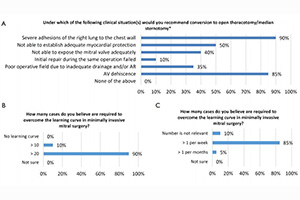Cross-sectional survey on minimally invasive mitral valve surgery
Abstract
Background: Minimally invasive mitral valve surgery (MIMVS) has become a standard technique to perform mitral valve surgery in many cardiac centers. However, there remains a question regarding when MIMVS should not be performed due to an increased surgical risk. Consequently, expert surgeons were surveyed regarding their opinions on patient factors, mitral valve pathology and surgical skills in MIMVS.
Methods: Surgeons experienced in MIMVS were identified through an electronic search of the literature. A link to an online survey platform was sent to all surgeons, as well as two follow-up reminders. Survey responses were then submitted to a central database and analyzed.
Results: The survey was completed by 20 surgeons. Overall results were not uniform with regard to contraindications to performing MIMVS. Some respondents do not consider left atrial enlargement (95% of surgeons), complexity of surgery (75%), age (70%), aortic calcification (70%), EuroSCORE (60%), left ventricular ejection fraction (55%), or obesity (50%) to be contraindication to surgery. Ninety percent of respondents believe more than 20 cases are required to gain familiarity with the procedure, while 85% believe at least one MIMVS case needs to be performed per week to maintain proficiency. Eighty percent recommend establishment of multi-institutional databases and standardized surgical mentoring courses, while 75% believe MIMVS should be incorporated into current training programs for trainees.
Conclusions: These results suggest that MIMVS has been accepted as a treatment option for patients with mitral valve pathologies according the expert panel. Initial training and continuing practice is recommended to maintain proficiency, as well as further research and formalization of training programs.
Cover






